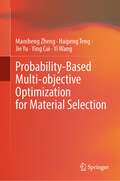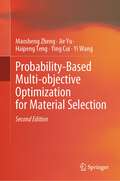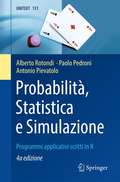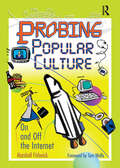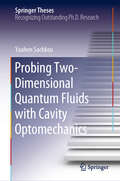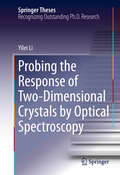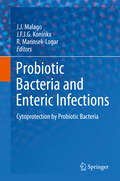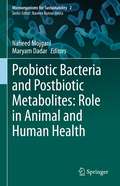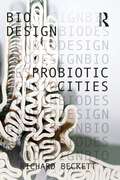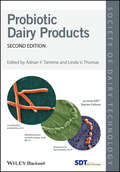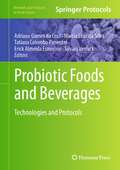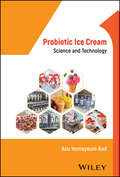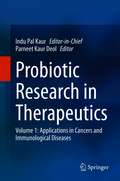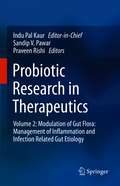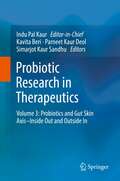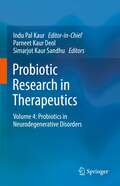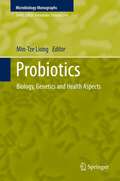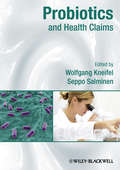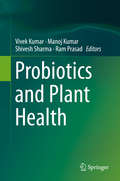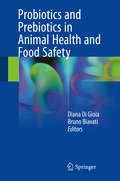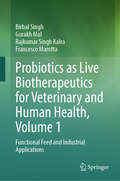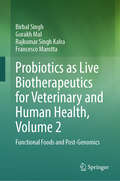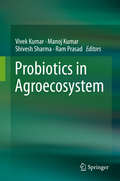- Table View
- List View
Probability-Based Multi-objective Optimization for Material Selection
by Ying Cui Yi Wang Jie Yu Maosheng Zheng Haipeng TengThis book illuminates the fundamental principle and applications of probability-based multi-objective optimization for material selection systematically, in which a brand new concept of preferable probability and its assessment as well as other treatments are introduced by authors for the first time. Hybrids of the new approach with experimental design methodologies, such as response surface methodology, orthogonal experimental design, and uniform experimental design, are all performed; the conditions of the material performance utility with desirable value and robust assessment are included; the discretization treatment of complicated integral in the evaluation is presented. The authors wish this work will cast a brick to attract jade and would make its contributions to relevant fields as a paving stone. This book can be used as a textbook for postgraduate and advanced undergraduate students in material relevant majors, and a reference book for scientists and engineers digging in the related fields.
Probability-Based Multi-objective Optimization for Material Selection
by Ying Cui Yi Wang Jie Yu Maosheng Zheng Haipeng TengThe second edition of this book illuminates the fundamental principle and applications of probability-based multi-objective optimization for material selection in viewpoint of system theory, in which a brand new concept of preferable probability and its assessment as well as other treatments are introduced by authors for the first time. Hybrids of the new approach with experimental design methodologies (response surface methodology, orthogonal experimental design, and uniform experimental design) are all performed; robustness assessment and performance utility with desirable value are included; discretization treatment in the evaluation is presented; fuzzy-based approach and cluster analysis are involved; applications in portfolio investment and shortest path problem are concerned as well. The authors wish this work will cast a brick to attract jade and would make its contributions to relevant fields as a paving stone. It is designed to be used as a textbook for postgraduate and advanced undergraduate students in relevant majors, while also serving as a valuable reference book for scientists and engineers involved in related fields.
Probability-Based Structural Fire Load
by P. E. Leo Razdolsky S. E.In the structural design of airframes and buildings, probability-based procedures are used to mitigate the risk of failure as well as produce cost-effective designs. This book introduces the subject of probabilistic analysis to structural and fire protection engineers and can also be used as a reference to guide those applying this technology. In addition to providing an understanding of how fire affects structures and how to optimize the performance of structural framing systems, Probability-Based Structural Fire Load provides guidance for design professionals and is a resource for educators. The goal of this book is to bridge the gap between prescriptive and probability-based performance design methods and to simplify very complex and comprehensive computer analyses to the point that stochastic structural fire loads have a simple, approximate analytical expression that can be used in structural analysis and design on a day-to-day basis. Numerous practical examples are presented in step-by-step computational form.
Probabilità, Statistica e Simulazione: Programmi applicativi scritti in R (UNITEXT #131)
by Alberto Rotondi Paolo Pedroni Antonio PievatoloIl libro contiene in forma compatta il programma svolto negli insegnamenti introduttivi di Statistica e tratta alcuni argomenti indispensabili per l'attività di ricerca, come le tecniche di simulazione Monte Carlo, i metodi di inferenza statistica, di best fit e di analisi dei dati di laboratorio. Gli argomenti vengono sviluppati partendo dai fondamenti, evidenziandone gli aspetti applicativi, fino alla descrizione dettagliata di molti casi di particolare rilevanza in ambito scientifico e tecnico. Il testo è rivolto agli studenti universitari dei corsi ad indirizzo scientifico e a tutti quei ricercatori che devono risolvere problemi concreti che coinvolgono l’analisi dei dati e le tecniche di simulazione. In questa edizione, completamente rivista e corretta, sono stati aggiunti alcuni importanti argomenti sul test d’ipotesi (a cui è stato dedicato un capitolo interamente nuovo) e sul trattamento degli errori sistematici. Per la prima volta è stato adottato il software R, con una ricca libreria di programmi originali accessibile al lettore.
Probing Popular Culture: On and Off the Internet
by Marshall Fishwick"When it comes to seeing depth and lateral connections in the development of popular culture, nobody exceeds Marshall Fishwick." -Canadian Psychology In Probing Popular Culture: On and Off the Internet, one of the leading authorities in American and popular culture studies presents an eye-opening examination o
Probing Two-Dimensional Quantum Fluids with Cavity Optomechanics (Springer Theses)
by Yauhen SachkouSuperfluid helium is a quantum liquid that exhibits a range of counter-intuitive phenomena such as frictionless flow. Quantized vortices are a particularly important feature of superfluid helium, and all superfluids, characterized by a circulation that can only take prescribed integer values. However, the strong interactions between atoms in superfluid helium prohibit quantitative theory of vortex behaviour. Experiments have similarly not been able to observe coherent vortex dynamics.This thesis resolves this challenge, bringing microphotonic techniques to bear on two-dimensional superfluid helium, observing coherent vortex dynamics for the first time, and achieving this on a silicon chip. This represents a major scientific contribution, as it opens the door not only to providing a better understanding of this esoteric quantum state of matter, but also to building new quantum technologies based upon it, and to understanding the dynamics of astrophysical superfluids such as those thought to exist in the core of neutron stars.
Probing Unconventional Transport Regimes in Delafossite Metals (Springer Theses)
by Philippa H. McGuinnessThis thesis describes in-depth studies of the remarkable electronic transport within the ultrahigh conductivity delafossite metals PtCoO_2 and PdCoO_2 using the tool of focused ion beam (FIB) microstucturing. Despite being first synthesised over 50 years ago, important questions remain regarding both the origin of the unusually high conductivity of these compounds and the consequences of their unique properties for unconventional electronic transport, such as that within the ballistic regime. The thesis explores both these areas.High-energy electron irradiation is used to examine the effects of deliberately introducing point defects into PdCoO_2 and PtCoO_2, demonstrating that the extremely low resistivity of these materials stems from an extreme purity as high as 1 defect in 120,000 atoms, rather than a novel scattering suppression mechanism. In addition, studies of the electronic transport in micron-scale squares of these metals show that their broadly hexagonal Fermi surfaces lead not only to long range ballistic behaviour but novel ballistic regime phenomena which cannot be observed in materials with a higher-symmetry Fermi surface.
Probing the Response of Two-Dimensional Crystals by Optical Spectroscopy
by Yilei LiThis thesis focuses on the study of the optical response of new atomically thin two-dimensional crystals, principally the family of transition metal dichalcogenides like MoS2. One central theme of the thesis is the precise treatment of the linear and second-order nonlinear optical susceptibilities of atomically thin transition metal dichalcogenides. In addition to their significant scientific interest as fundamental material responses, these studies provide essential knowledge and convenient characterization tools for the application of these 2D materials in opto-electronic devices. Another important theme of the thesis is the valley physics of atomically thin transition metal dichalcogenides. It is shown that the degeneracy in the valley degree of freedom can be lifted and a valley polarization can be created using a magnetic field, which breaks time reversal symmetry in these materials. These findings enhance our basic understanding of the valley electronic states and open up new opportunities for valleytronic applications using two-dimensional materials.
Probiotic Bacteria and Enteric Infections
by J.F.J.G. Koninkx R. Marinsek-Logar J. J. MalagoEvery day many people suffer from intestinal diseases. These disorders can result from pathogens like bacteria, fungi, parasites and viruses, but the causes of non-infectious intestinal disorders and colorectal cancers remain to be elucidated. Disturbances to the normal gut flora (the microbiota) are central to the development of many, if not all, of these disorders. Disturbed gut microbiota is a prelude to public health issues like traveller's-, antibiotic- and Clostridium difficile-associated diarrhoea, irritable bowel syndrome, inflammatory bowel disease, and colorectal cancers. This book discusses the way intestinal disorders affect the microbiota, how the disturbed microbiotal balance leads to enteric disorders and the ways to prevent these disorders. Further his book explores the potential of probiotics (live microorganisms that when ingested bring a health benefit) in treating enteric disorders by analysing the probiotic genome through proteomics, metabolomics and functional assays. Discussed is how the ingestion of specific microorganisms repairs the disturbed microbiota and subsequently ameliorates enteric disorders. Finally this book addresses how genetic engineering and biotechnology will contribute to the development of effective and safe designer probiotics.
Probiotic Bacteria and Postbiotic Metabolites: Role in Animal and Human Health (Microorganisms for Sustainability #2)
by Naheed Mojgani Maryam DadarThis book covers all aspects of probiotic bacteria and their metabolites, as well as their role and significance in human and animal health. Given the role of probiotic bacterial strains in the production of short chain fatty acids, butyrate etc probiotics may be considered as an alternative approach for the prevention or treatment of intestinal dysbiosis, cancers, cardiovascular diseases, hypertensions. Additionally, the significance of probiotics added in aquaculture systems for improving health, performance and growth of aquatic organisms has been highlighted. In this book, the multi-functional role of probiotics and their post-biotic metabolites in improving overall health status of man and animals, is discussed. It is a comprehensive compilation useful for researchers, academics, veterinarians and students in the field of microbiology, food technology and biotechnology.
Probiotic Cities (Bio Design)
by Richard BeckettProbiotic Cities covers a body of work that is at the forefront of emerging knowledge within architecture, towards designing informed indoor and built environment microbiomes. Sited within the broader field of Bio Design, the book presents highly experimental design research at the intersection of architecture, engineering and microbiology. The book describes work which explores novel strategies towards directly (re)introducing beneficial microbes into buildings and cities. Through discussion of both the work and the processes and methodologies used, it provides a framework to enable designers and practitioners to begin to engage with contemporary human–microbe relationships towards the design of healthy and resilient cities. The book defines a new microbial paradigm for architecture that engages with broader emerging ecological or ‘more than human’ philosophies for design within the age of the Anthropocene.
Probiotic Dairy Products
by Adnan Y. Tamime Linda V. ThomasProbiotic Dairy Products, 2nd Edition The updated guide to the most current research and developments in probiotic dairy products The thoroughly revised and updated second edition of Probiotic Dairy Products reviews the recent advancements in the dairy industry and includes the latest scientific developments in regard to the 'functional' aspects of dairy and fermented milk products and their ingredients. Since the publication of the first edition of this text, there have been incredible advances in the knowledge and understanding of the human microbiota, mainly due to the development and use of new molecular analysis techniques. This new edition includes information on the newest developments in the field. It offers information on the new ‘omic’ technologies that have been used to detect and analyse all the genes, proteins and metabolites of individuals’ gut microbiota. The text also includes a description of the history of probiotics and explores the origins of probiotic products and the early pioneers in this field. Other chapters in this resource provide valuable updates on genomic analysis of probiotic strains and aspects of probiotic products’ production and quality control. This important resource: Offers a completely revised and updated edition to the text that covers the topic of probiotic dairy products Contains 4 brand new chapters on the following topics: the history of probiotics, prebiotic components, probiotic research, and the production of vitamins, exopolysaccharides (EPS), and bacteriocins Features a new co-editor and a host of new contributors, that offer the latest research findings and expertise Is the latest title in Wiley's Society of Dairy Technology Technical Series Probiotic Dairy Products is an essential resource for dairy scientists, dairy technologists and nutritionists. The text includes the results of the most reliable research in field and offers informed views on the future of, and barriers to, the progress for probiotic dairy products.
Probiotic Foods and Beverages: Technologies and Protocols (Methods and Protocols in Food Science)
by Adriano Gomes da Cruz Marcia Cristina Silva Tatiana Colombo Pimentel Erick Almeida Esmerino Silvani VerruckThis volume details state-of-the-art protocols on manufacturing functional probiotic foods and beverages. Chapters guide readers through processing procedures, probiotic strains, probiotic cheese, probiotic fermented milk, probiotic ice cream manufacturing, probiotic butter, plant-based beverages, probiotic plant-based cheeses, probiotic-fermented vegetables, Kombucha, probiotic beer, Friolano-type sausage, delivery of probiotics through bakery goods, synbiotic chocolate, methods on encapsulation of probiotics, paraprobiotics, and protocols for food products with psychobiotic potential. Written in the format of the Methods and Protocols in Food Science series, chapters list necessary materials and methods for readily reproducible protocols. Authoritative and cutting-edge, Probiotic Foods and Beverages: Technologies and Protocols aims to be a comprehensibly guide with well-established protocols and procedures.
Probiotic Ice Cream: Science and Technology
by Aziz Homayouni-RadComprehensive resource on probiotics as applied to ice cream and frozen desserts, covering fundamentals, development, technology, and quality control Probiotic Ice Cream is the first book to look at probiotics as applied to ice cream and frozen desserts, covering the whole product development process, from essential fundamentals to formulation and characterization of the final product. Written by a highly qualified specialist with significant research experience in this unique field, Probiotic Ice Cream includes information on: Science of probiotic ice cream, covering principles of probiotics and how to select appropriate probiotic strains for use in ice creamPhysical protection of probiotics in ice cream conditions, as well as nutritional value of functional ice cream for humansTechnology of probiotic ice cream, covering the definition, formulation, and characterization of prebiotic, probiotic, synbiotic and postbiotic ice creamsQuality control, with information on the physico-chemical and rheological properties, sensory properties, and shelf-life evaluation and packaging of probiotic ice cream Probiotic Ice Cream is an authoritative, comprehensive, and one-of-a-kind reference on the subject, ideal for dairy scientists, frozen desserts manufacturers, supermarkets, and food product developers, as well as students in related programs of study.
Probiotic Research in Therapeutics: Volume 1: Applications in Cancers and Immunological Diseases
by Indu Pal KaurThe volume sheds new light on role of gut dysbiosis in cancer and immunological diseases and their clinical manifestations. Contributions in the volume discuss about the gut microbiota as a therapeutic target and the role of probiotics in its management. The volume explores application of probiotics in the treatment of various cancers viz. colorectal, gastric, lung, and breast cancer and immunological diseases. The volume comprises of chapters from expert contributors organized into various important themes which include, introduction, relationship between gut microbiota and disease condition, mechanisms involved, clinical and in vivo status, conclusion and future directions. This is a highly informative and carefully presented book, providing recent and innovative insight for scholars and researchers with an interest in probiotics and its applications in cancer and immunological diseases.
Probiotic Research in Therapeutics: Volume 2: Modulation of Gut Flora: Management of Inflammation and Infection Related Gut Etiology
by Indu Pal KaurIn a normal physiological state, several bacteria are present in the human gut that is essential to maintain the normal to healthy gastrointestinal function. Disturbances in this “normal flora” lead to gut inflammation and infection. This volume explores the potential of probiotics, the healthy bacteria, to manage gut-related diseases including gastrointestinal cancers, ulcerative colitis, H. pylori infections, and diarrhea; vaginosis; oral health; airway inflammation; and atopic dermatitis. The concept of designer probiotics, edible vaccines and future scope of research in the field is also presented. The animal models used for studying the benefits of probiotics in gut inflammation are described for beginners.
Probiotic Research in Therapeutics: Volume 3: Probiotics and Gut Skin Axis–Inside Out and Outside In
by Indu Pal KaurRecent research in science establishes a direct relation between human gut and skin. Several species of live microbes inhabit the human skin and intestines which far outnumbers the mammalian cells in the human body. Research interest of Nextgen scientists is focused on beneficially harnessing this microbial population to address skin disorders like acne, rosacea, eczema, premature aging, and skin cancer which are established to be a result of skin-microbiome dysbiosis. This volume highlights evidence-based endeavours of the scientific community in this sector. Currently there is no concrete literature which gives a detailed vision on the relationship between gut microbiota and skin related disorders. This volume is an attempt to put together available data in the area and demonstrate usefulness of probiotics as a new therapeutic option for management of these skin diseases which currently show poor prognosis, high cost of treatment and compromised quality of life of the patient.
Probiotic Research in Therapeutics: Volume 4: Probiotics in Neurodegenerative Disorders
by Indu Pal KaurHumans have numerous microorganisms residing in the body, especially in the gut, far exceeding the human body's normal mammalian cells. Recent research links the gut microbiome, the population of microorganisms living in the gastrointestinal tract, with brain diseases. This volume explores the concept and possibility of its extension to manage a galaxy of CNS diseases, including Parkinson's, Alzheimer's, Autism spectrum disorders, depression, insomnia, and chronic fatigue syndrome. This volume elaborates about communication channels between gut and brain via the vagus nerve, short-chain fatty acids including omega acids, and other inflammasomes.In contrast to the available books on the topic, this title is more versatile and endeavors to bring together scientific pre-clinical, and clinical claims on the probable psychobiotic implication of probiotic therapy. The book will appeal similar to the general public, students, experienced researchers, and academicians. It is endeavored to address an aspect of probiotic usage beyond gut disorders. We hope that it would be helpful to people studying the human nervous system and related conditions with their treatments.
Probiotics
by Min-Tze LiongProbiotic microorganisms have a long history of use, and their health benefits for hosts are well documented. This Microbiology Monographs volume provides an overview of the current knowledge and applications of probiotics. Reviews cover the biology and probiotic potential of the thoroughly studied prokaryotic genera Lactobacillus and Bifidobacterium, several eukaryotic microorganisms, probiotic strain characterization, and the analytical methods (such as FISH, microarray, and high throughput sequencing) required for their study. Further chapters describe the positive effects of probiotics on malabsorption disorders such as diarrhea and lactose intolerance, and document the clinical evidence of benefits in treating allergies and lung emphysema, and in dermatological applications. Also addresses are topics such as genetically engineered strains, new carriers for probiotics, protection techniques, challenges of health claims, safety aspects, and future market trends.
Probiotics and Health Claims
by Wolfgang Kneifel Seppo SalminenThis book examines the international picture regarding probiotic food applications, placing a particular emphasis on the legal context and assessment procedures of probiotic health claims in the major markets for these products. Health claim legislation is described and the ways in which manufacturers can ensure compliance are discussed. The book also covers the use of meta-analysis to assess available data, and case examples from various regulatory cultures and traditions are included. It will be of interest to food industry scientists, executives and R&D personnel; international regulatory advisers and administrators; researchers, educators and students on food science courses. Key Features: Focuses on health claim legislation for this commercially important food sector Includes chapters on the current situation in all the major world markets including Europe, the USA, Japan, India and China Covers food, feed and pharmaceutical applications of probiotics
Probiotics and Plant Health
by Manoj Kumar Ram Prasad Vivek Kumar Shivesh SharmaThis book primarily focuses on microbial colonization, its role in plant growth and nutrient cycling, mycorrhizae, and providing an overview of phytospheric microorganisms in sustainable crop systems. Despite the advances made in the study of plant-microbe synergism, the relation between microbes and plant health in the context of food security, soil nutrient management, human and plant health is still largely unexplored. Addressing that gap, the book presents reviews and original research articles that highlight the latest discoveries in plant probiotics, their specificity, diversity and function. Additional sections addressing nutrient management, human health, and plant microbiome management to improve plant productivity round out the coverage.
Probiotics and Prebiotics in Animal Health and Food Safety
by Diana Di Gioia Bruno BiavatiThis book discusses the role of probiotics and prebiotics in maintaining the health status of a broad range of animal groups used for food production. It also highlights the use of beneficial microorganisms as protective agents in animal derived foods. The book provides essential information on the characterization and definition of probiotics on the basis of recently released guidelines and reflecting the latest trends in bacterial taxonomy. Last but not least, it discusses the concept of “dead” probiotics and their benefits to animal health in detail. The book will benefit all professors, students, researchers and practitioners in academia and industry whose work involves biotechnology, veterinary sciences or food production.
Probiotics as Live Biotherapeutics for Veterinary and Human Health, Volume 1: Functional Feed and Industrial Applications
by Birbal Singh Gorakh Mal Francesco Marotta Rajkumar Singh KalraThis Volume 1 of a two-volume work provides an up-to-date overview of the latest advances in live biotherapeutics research. It focuses on key areas within probiotics and microbiome studies from the veterinary sciences including their translation into commercial applications. The book is divided into three sections, comprising (I) fundamentals about probiotic resources, (II) probiotics for veterinary health, with chapters on farm animals, pets, wildlife and aquaculture, and (III) industrial applications of probiotics. The broad spectrum of industry-relevant contributions makes this work a valuable resource for industry professionals as well as researchers in functional feed and food biotechnology, applied veterinary microbiology and gastroenterology. Presenting novel and evidence-based research, this volume will drive the commercial enterprise and meets the great demand for good probiotic products in the veterinary medical sector.
Probiotics as Live Biotherapeutics for Veterinary and Human Health, Volume 2: Functional Foods and Post-Genomics
by Birbal Singh Gorakh Mal Francesco Marotta Rajkumar Singh KalraThis Volume 2 of a two-volume work provides an up-to-date overview of the latest advances in live biotherapeutics research, engineered and genome-edited probiotics. It focuses on key areas within probiotics and microbiome studies in human medicine, including their translation into commercial applications. The book is divided into three sections, comprising (I) biomedical and nutritional benefits of probiotics for human health, (II) post-genomic technologies in probiotics sciences and genome engineering, and (III) biosafety aspects and prospects of biotherapeutics. The broad spectrum of industry-relevant contributions makes this work a valuable resource for industry professionals as well as researchers in functional food and feed biotechnology, applied microbiology and gastroenterology. Presenting novel and evidence-based research, this volume will drive the commercial enterprise and meets the great demand for good probiotic products in the human medical sector.
Probiotics in Agroecosystem
by Manoj Kumar Ram Prasad Vivek Kumar Shivesh SharmaThis book focuses on food security in sustainable agriculture and nutrient management. The study of plant probiotic microbes' synergism using existing techniques has greatly improved our grasp of the structure and functioning of the plant microbiome. However, the function of plant probiotic microbes and their relation to plants' health in the context of food security, soil nutrient management, human and plant health are largely unexplored. Compared to human probiotics, diverse types and millions of microbiota inhabit plants, forming multifaceted and complicated ecological societies that stimulate plant growth and health through their combined metabolic activities. From the perspective of sustainable cropping systems, observing plant probiotics can provide insights on how to stimulate and maintain plant productivity, along with host stress tolerance and recycling of soil nutrients. This book combines reviews and original research articles to highlight the latest advances in plant probiotics, their specificity, diversity, function, as well as plant microbiome management to improve plant growth and productivity, nutrient management and human health.
